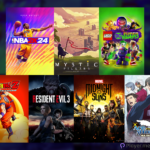Two tech giants, Meta (Formerly Facebook) and Apple, are gearing up for intense competition in the realm of Mixed Reality (MR) with their latest offerings: The Meta Quest 3 and the Apple Vision Pro. These two headsets are set to redefine the way we experience virtual and augmented reality, and the battle for supremacy is on.
Meta Quest 3: A VR Powerhouse with Mixed Reality Ambitions
The Meta Quest 3 boasts several key improvements over its predecessor, the Meta Quest 2. Its dual 2064 × 2208 pixel displays offer a substantial bump in screen clarity, making VR worlds even more immersive. Under the hood, it features the second-generation Qualcomm Snapdragon XR2 chipset, promising graphics performance twice as fast as the Meta Quest 2. While it may not match a high-end PC graphics card, it bridges the gap and ensures smoother, more detailed gameplay.
The design of the Meta Quest 3 has also seen refinements. It’s slightly more compact and sports a comfortable rubber face mask that’s easy to clean after intense VR sessions. The head fixture now accommodates hair buns and ponytails better, catering to a wider audience.
The Meta Quest 3’s controllers have received an overhaul, too. By removing the LED tracking ring and improving tracking algorithms, Meta aims to enhance the user experience. The addition of a charging dock with rechargeable batteries further streamlines the setup. Battery life for the headset itself remains consistent, lasting between two and three hours.
Read More: Meta Is Developing a New, More Powerful AI System as Technology Race Escalates
Mixed Reality Takes Center Stage
One of the most significant advancements in the Meta Quest 3 is its foray into mixed reality. Meta’s mixed reality features combine elements of the real world with digital overlays, creating a seamless blend of the physical and virtual realms. While MR has been around, Meta’s implementation aims to make it mainstream.
The Meta Quest 3 incorporates two colour cameras similar to those found in the Quest Pro, providing users with a pass-through feed of their surroundings. What sets the Meta Quest 3 apart is the notable improvement in pass-through quality. The feed is less grainy, with better colour balance, making it more practical for everyday use. Users can even check their phones through the pass-through feed, something that wasn’t as clear on previous models.
Another innovation is the addition of a depth sensor, allowing for more accurate scanning of physical surroundings. This sensor eliminates the need for users to manually trace boundaries for the virtual reality mode, simplifying the setup process. The Meta Quest 3’s ability to seamlessly switch between virtual and mixed reality with a simple double-tap adds to its convenience.
Apple Vision Pro: A Vision of Mixed Reality Elegance
On the other side of the ring stands Apple, known for its sleek and innovative designs. The Apple Vision Pro, although yet to be released, is already generating buzz in the mixed reality arena. Apple’s approach to mixed reality is characterised by elegance, simplicity, and functionality.
The Vision Pro aims to address some pain points associated with VR headsets, such as discomfort and neck strain. Apple’s focus is on making the headset smaller, lighter, and more comfortable to wear for extended periods. The headset will feature higher-resolution pass-through cameras, enabling users to see the real world around them with greater clarity.
Under the hood, the Vision Pro boasts the powerful M2 chip, ensuring a smooth and responsive experience. Sharper VR displays further enhance the overall visual quality.
One standout feature of the Vision Pro is its approach to controls. Instead of relying solely on traditional controllers, Apple is introducing sophisticated eye- and hand-control features. This innovation not only adds convenience but also reduces the need for additional accessories.
Also Read: Brand New SteamVR 2.0 and Valve’s Groundbreaking Hardware Speculations
The Battle Unfolds: Meta vs. Apple
The competition between Meta and Apple promises to reshape the landscape of mixed reality and VR. Each company brings its own strengths and philosophies to the table.

Meta, with its Meta Quest 3, aims to strike a balance between affordability and high-quality VR experiences. The inclusion of mixed reality features adds an exciting dimension, making it a versatile choice for consumers looking to explore the digital and physical worlds in new ways.
Apple, on the other hand, focuses on delivering a premium mixed reality experience with the Vision Pro. The emphasis on comfort, elegant design, and advanced control methods positions it as a potential game-changer in the industry.
Conclusion
While Meta is “Afraid of Apple,” as Mark Gurman noted, the outcome of this competition remains uncertain. Both companies have the potential to redefine how we interact with technology, whether it’s gaming, productivity, or entirely new experiences we’ve yet to imagine.
As consumers, we are on the brink of a mixed reality revolution, and the Meta Quest 3 and Apple Vision Pro are leading the charge. The choice between them will ultimately depend on your priorities, whether it’s affordable versatility or premium elegance. One thing is for sure: the future of mixed reality has never looked more exciting.
Frequently Asked Questions
What Are the Key Differences Between the Meta Quest 3 and Apple Vision Pro?
The Meta Quest 3 and Apple Vision Pro differ significantly in price, with the Meta Quest 3 priced at $499, targeting a broader consumer market, while the Vision Pro is expected to be considerably more expensive, likely exceeding $3,000, catering to high-end users. Additionally, it emphasises comfort with features like a soft rubber face mask and accommodations for hairstyles, while the Vision Pro aims for a smaller and lighter design for extended wear. In terms of control methods, the Meta Quest 3 relies on traditional controllers, while the Vision Pro is anticipated to introduce advanced control methods, potentially including eye- and hand-tracking.
Which Company Is Leading the Way in Terms of Control Methods: Meta or Apple?
Apple is taking the lead in terms of control methods, especially with its upcoming Vision Pro headset. While the Meta Quest 3 utilises traditional controllers and some hand gestures, Apple’s Vision Pro is poised to introduce groundbreaking control methods such as eye- and hand-tracking. These innovations could redefine user interaction with mixed reality environments, potentially reducing the reliance on external controllers and offering a more intuitive and immersive experience.
What Is the Concept of Mixed Reality and How It’s Implemented in These Headsets?
Mixed Reality (MR) is a technology that blends elements of both Virtual Reality (VR) and Augmented Reality (AR), allowing users to interact with digital objects and information while remaining aware of their physical surroundings. In the context of the Meta Quest 3, MR is implemented through features like improved pass-through quality, a depth sensor for more accurate spatial awareness, and the ability to seamlessly switch between VR and MR modes. The Apple Vision Pro is expected to offer high-resolution pass-through cameras and advanced control methods, enhancing the MR experience by overlaying digital information onto the real world, making it more interactive and immersive for users.





